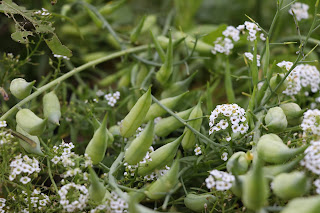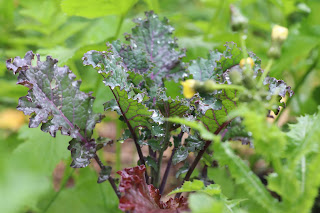Saturday, 23 October 2021
Saturday, 2 October 2021
The UBC Orchard Garden – Summer Work Party: Implementing Phase 2 of our Food Forest
During a work-party in early
June, the UBC Orchard Garden community implemented the second phase of
our food forest by adding dozens of fruiting shrubs (blueberries,
honeyberries, gooseberries, and currants) that will
grow beneath our fruit and nut trees.
What is a food forest?
In technical terms, a food forest is 'a perennial polyculture of multi-purpose plants’ (Jacke and Toesnmeier, 2005). Generally, the plants that are used are perennial, meaning that they come back every year (e.g. trees). A monoculture is a plot of land that is planted with a single species typically grown in rows that are evenly spaced throughout a field, whereas a polyculture is planted with several difference species generally using more naturalistic planting patterns. Finally, although one of the goals of creating a food forest is often the production of food (e.g. apples, pears, hazelnuts, etc.), they are multi-purpose and can also be used to produce fuel, fiber, fodder, fertilizer (f)pharmaceuticals, and fun (Jacke and Toesnmeier, 2005).
In addition to the physical materials that food forests can provide, they also have ecological value! Supporting biodiversity can be a primary goal, or indirect benefit of gardening ‘like the forest’ (Jacke and Toesnmeier, 2005). This is because a food forest, similar to a natural forest, is composed of a variety of vertical ‘layers’ (e.g. the tree canopy, the shrub layer, a herbaceous ground cover, etc.) each of which provides a variety of ‘niches’ (i.e. a particular set of environmental conditions) that can be occupied by organisms (e.g. bees, birds, butterflies). Most organisms are best adapted to a particular range of environmental conditions, and because forest gardens can offer a broad range of micro-climates and a diversity of plants, insects and wildlife can find refuge in them. Furthermore, because we grow edible plants in multiple vertical layers, the potential for ‘additive yielding’ occurs (Jacke and Toesnmeier, 2005). Additive yielding is the cumulation of food produced by say, a thyme groundcover that grows beneath a blueberry bush which grows beneath a cherry tree.
If you are interested in visiting our food forest, or learning more about food forests, ecological gardening and other related activities, sign-up for our newsletter to keep informed about volunteer opportunities and upcoming workshops.
Hope to see you soon!
Shane
What is a food forest?
In technical terms, a food forest is 'a perennial polyculture of multi-purpose plants’ (Jacke and Toesnmeier, 2005). Generally, the plants that are used are perennial, meaning that they come back every year (e.g. trees). A monoculture is a plot of land that is planted with a single species typically grown in rows that are evenly spaced throughout a field, whereas a polyculture is planted with several difference species generally using more naturalistic planting patterns. Finally, although one of the goals of creating a food forest is often the production of food (e.g. apples, pears, hazelnuts, etc.), they are multi-purpose and can also be used to produce fuel, fiber, fodder, fertilizer (f)pharmaceuticals, and fun (Jacke and Toesnmeier, 2005).
In addition to the physical materials that food forests can provide, they also have ecological value! Supporting biodiversity can be a primary goal, or indirect benefit of gardening ‘like the forest’ (Jacke and Toesnmeier, 2005). This is because a food forest, similar to a natural forest, is composed of a variety of vertical ‘layers’ (e.g. the tree canopy, the shrub layer, a herbaceous ground cover, etc.) each of which provides a variety of ‘niches’ (i.e. a particular set of environmental conditions) that can be occupied by organisms (e.g. bees, birds, butterflies). Most organisms are best adapted to a particular range of environmental conditions, and because forest gardens can offer a broad range of micro-climates and a diversity of plants, insects and wildlife can find refuge in them. Furthermore, because we grow edible plants in multiple vertical layers, the potential for ‘additive yielding’ occurs (Jacke and Toesnmeier, 2005). Additive yielding is the cumulation of food produced by say, a thyme groundcover that grows beneath a blueberry bush which grows beneath a cherry tree.
If you are interested in visiting our food forest, or learning more about food forests, ecological gardening and other related activities, sign-up for our newsletter to keep informed about volunteer opportunities and upcoming workshops.
Hope to see you soon!
Shane
Subscribe to:
Posts (Atom)
























